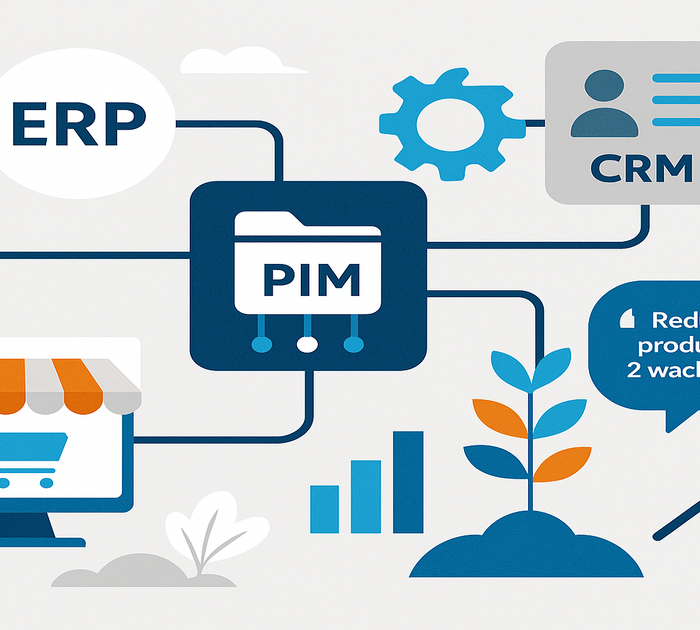Picture your product data as a relay race. SAP Business One holds the baton for item codes, costs, and inventory, while Perfion PIM sprints with marketing copy, images, and channel templates. When the hand-off misfires—think copy-paste updates and rogue spreadsheets—the race screeches to a halt. Consequently, if your manufacturing firm surpasses $30 million in revenue and sells through multiple channels, a rock-solid Perfion SAP Business One integration is the difference between launch-day panic and launch-day applause. Below is a human-friendly, field-tested playbook that shows you how to connect the dots—fast.
Why marry ERP and PIM in the first place?
Single source of truth – SAP Business One retains operational facts (SKU, BOM, stock levels); Perfion stores storytelling facts (benefit bullets, lifestyle imagery). Linking them eliminates double entry and, therefore, costly mistakes.
Accelerated launches – Whenever engineering adds a new item in SAP, Perfion instantly creates the companion record, queues required marketing fields, and even pings copywriters.
Error prevention – Updated prices in SAP flow instantly into every Perfion channel feed, slashing mismatched listings as well as painful credit notes.
Cross-team insight – Finance sees which SKUs drive e-commerce revenue, while marketing learns which SKUs move from quote to order fastest.
In short, integration is less about IT wizardry and more about giving every team real-time visibility without leaving its preferred system.
Tip 1: Settle data ownership before you touch an API
Before coding begins, decide which system rules each field. A quick RACI session now saves months of finger-pointing later.
SAP B1 controls: item code, cost, UoM, tax group, inventory.
Perfion owns: titles, feature bullets, images, translations, channel mappings.
Shared fields—GTIN, brand, launch date—remain editable in only one system. As a result, version wars simply disappear.
Tip 2: Cleanse data like your go-live depends on it (because it does)
Duplicate item codes, outdated attribute names, and “miscellaneous” categories lurk inside every ERP. Therefore, run a quick audit:
Purge dead SKUs or, at the very least, archive them.
Standardize naming conventions—no more “Red / RED / Rd.”
Consolidate units: millimeters or inches, never both.
Perfion’s import wizard flags any inconsistencies; however, the cleaner the source, the smoother the sync.
Tip 3: Use the native connector—custom code only if you love headaches
Perfion ships with a certified SAP Business One connector for both HANA and SQL. It supports bidirectional item-master sync, maps user-defined fields without ABAP gymnastics, and runs scheduled or real-time updates via the DI API or Service Layer. Therefore, start here; custom scripts become orphans as soon as SAP releases a patch.
Tip 4: Begin with “push,” then grow into “push-pull”
First, Perfion pushes enriched product data to SAP on a predictable schedule—hourly for fast movers or nightly for the long tail.
Next, SAP sends real-time price or inventory changes back to Perfion so everyone stays aligned.
Finally, Perfion republishes that fresh data to Amazon, Shopify, and dealer portals automatically. Short, iterative steps keep both risk and caffeine intake manageable.
Tip 5: Pilot a single product family before opening the floodgates
Choose a compact yet high-profile line—say, your best-selling power tools. Track import success rate, field-mapping accuracy, and the time from ERP item creation to live e-commerce listing. Once kinks are ironed out, roll out additional families. Over-zealous “big bang” migrations are where integrations go to die; therefore, resist the urge.
Tip 6: Automate validation and notifications
Configure Perfion to flag missing images or mismatched UoM values before data syncs. Push alerts to Slack or email so issues never hide in dusty log files. Consequently, the best errors are caught while still drafts.
Tip 7: Train humans, not just servers
Marketing learns to enrich descriptions without touching SAP.
Operations understands how Perfion tags items for channel compliance.
IT monitors integration logs and knows rollback procedures.
Meanwhile, celebrate quick wins—“The new drill went live on Amazon in two hours!”—to lock in new habits.
Real-world payoffs
Launch-cycle time cut by 50 %: One industrial fittings maker shrank “ERP item created” to “SKU live” from two weeks to four days.
Listing errors down to 0.5 %: Automatic UPC validation stopped costly Amazon rejections.
Revenue bump of 12 %: Faster, error-free listings translated into earlier buy-box wins and bigger Q4 numbers.
Clearly, tight integration equals faster cash.
Avoid these rookie mistakes
Skipping sandbox testing – Always validate in a test company first; undoing 10 000 bad records in production is career-limiting.
Ignoring change management – Users revert to spreadsheets if workflows feel clunky. Therefore, make new processes intuitive.
Hard-coding field names – SAP UDFs evolve; consequently, keep mappings configurable to avoid future pain.
Ready to connect the dots?
Perfion and SAP Business One are powerful alone, yet unstoppable together. Fonseca Advisers has guided dozens of manufacturers through design, implementation, and optimization—delivering wins without downtime.
Perfion offers a native connector that uses SAP’s DI API or Service Layer to synchronize item masters, user-defined fields, and updates—no bespoke code required.
Operational data like item codes, costs, and inventory remains in SAP; marketing data such as descriptions, images, and channel attributes resides in Perfion, ensuring each system handles what it does best.
A phased rollout with a limited catalog can go live in 6–8 weeks, while full catalog integration typically completes in 3–4 months, depending on data quality and customization levels.






